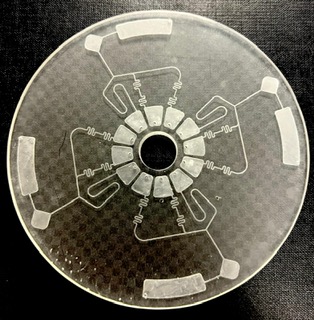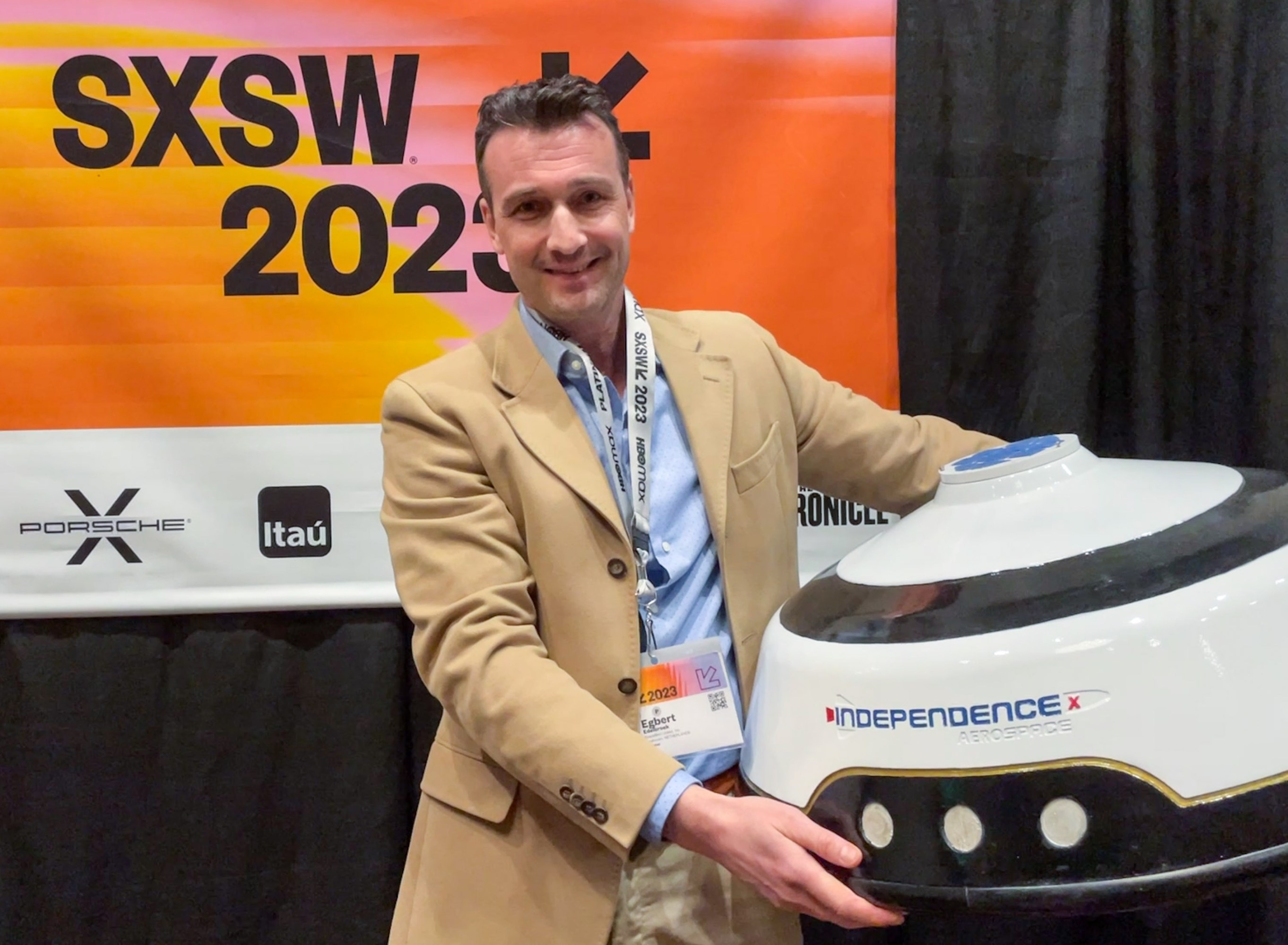
Egbert Edelbroek was acting as a sperm donor when he first wondered whether it’s possible to have babies in space.
Curious about the various ways that donated sperm can be used, Edelbroek, a Dutch entrepreneur, began to speculate on whether in vitro fertilization technology was possible beyond Earth—or could even be improved by the conditions found there. Could the weightlessness of space be better than a flat laboratory petri dish?
Now Edelbroek is CEO of SpaceBorn United, a biotech startup seeking to pioneer the study of human reproduction away from Earth. Next year, he plans to send a mini lab on a rocket into low Earth orbit, where in vitro fertilization, or IVF, will take place. If it succeeds, Edelbroek hopes his work could pave the way for future space settlements.
“Humanity needs a backup plan,” he says. “If you want to be a sustainable species, you want to be a multiplanetary species.”
Beyond future space colonies, there is also a more pressing need to understand the effects of space on the human reproductive system. No one has ever become pregnant in space—yet. But with the rise of space tourism, it’s likely that it will eventually happen one day. Edelbroek thinks we should be prepared.
Despite the burgeoning interest in deep space exploration and settlement, prompted in part by billionaires such as Elon Musk and Jeff Bezos, we still know very little about what happens to our reproductive biology when we’re in orbit. A report released in September by the US National Academies of Science, Engineering, and Medicine points out that almost no research has been done on human reproduction in space, adding that our understanding of how space affects reproduction is “vital to long-term space exploration, but largely unexplored to date.”
Some studies on animals have suggested that the various stages of reproduction—from mating and fertilization to embryo development, implantation, pregnancy, and birth—can function normally in space. For example, in the very first such experiment, eight Japanese medaka fish developed from egg to hatchling aboard the space shuttle Columbia in 1994. All eight survived the return to Earth and seemed to behave normally.
Taking it step by step
Yet other studies have found evidence that points to potential problems. Pregnant rats that spent much of their third trimester—a total of five days—on a Soviet satellite in 1983 experienced complications during labor and delivery. Like all astronauts returning to Earth, the rats were exhausted and weak. Their deliveries lasted longer than usual, likely because of atrophied uterine muscles. All the pups in one of the litters died during delivery, the result of an obstruction thought to be due in part to the mother’s weakened state.
To Edelbroek, these inconclusive results point to a need to systematically isolate each step in the reproductive process in order to better understand how it is affected by conditions like lower gravity and higher radiation exposure. The mini lab his company developed is designed to do exactly that. It is about the size of a shoebox and uses microfluidics to connect a chamber containing sperm to a chamber containing an egg. It can also rotate at different speeds to replicate the gravitational environment of Earth, the moon, or Mars. It is small enough to fit inside a capsule that can be housed on top of a rocket and launched into space.

After the egg has been fertilized in the device, it splits into two cells, each of which divides again to form four cells and so on. After five to six days, the embryo reaches a stage known as a blastocyst, which looks like a hollow ball. At this point, the embryos in the mini lab will be cryogenically frozen for their return to Earth.
But first, SpaceBorn needs to demonstrate that the device works in space. Edelbroek’s plans to test it were revealed at the SXSW festival in March this year.
“We have our first prototype finished, and it’s going to go on board a rocket this year—within six months,” he told the audience.
That turned out to be overly optimistic. During a Zoom meeting of the SpaceBorn United advisory board in August, Edelbroek explained that a company that had been contracted to perform the launch in Iceland had not yet secured the necessary launch permits. Edelbroek decided to scrub the suborbital test and is now targeting a loftier goal—a three-hour orbital test of the device with the German startup Atmos Space Cargo, tentatively scheduled for November 2024.
“You want to find this stuff out in a petri dish before you’ve got tourists getting pregnant in space.”
If it is able to pull off this test, SpaceBorn United plans to move forward with additional test flights following the plan for its mission, known as ARTIS (Assisted Reproductive Technology in Space). As described on its website, the first few ARTIS missions will involve rodent embryos fertilized in space using simulated gravity equivalent to that on Earth. Next, the embryos that were formed in space and cryogenically frozen for their return to Earth will be implanted into a rodent mother. If this results in the birth of healthy pups, later ARTIS missions will include human embryos fertilized under Earth-like gravity and, eventually, partial gravity similar to that of the moon or Mars.
If these experiments show that human embryos can be formed under those low-gravity conditions, Edelbroek believes, it would be a major advance toward demonstrating the feasibility of multigenerational space settlements.
“I feel like we definitely need this kind of research to be done,” says Kelly Weinersmith, a biologist and coauthor of a forthcoming book about space settlement titled A City on Mars. “I do feel like it’s worth making humans multiplanetary as, like, a plan B,” she says. “But I think we need to do it slowly.”
Edelbroek also sees a more immediate need for the research. As access to space expands, and especially as the space tourism industry grows, it becomes increasingly likely that a baby could be conceived in space, intentionally or otherwise. Currently, there is very little understanding of how a space pregnancy could affect either the mother or the unborn child. Edelbroek sees the company’s IVF studies as urgently needed to help inform such risks.

Weinersmith agrees. “You want to find this stuff out in a petri dish before you’ve got tourists getting pregnant in space,” she says.
Currently, SpaceBorn United is among only a handful of research groups working on reproduction in space. That is largely because there has been very little public funding available for the research. NASA, the European Space Agency, and other governmental organizations have historically been reluctant to fund and support research on sex and human reproduction.
Erik Antonsen, an associate professor of space medicine at Baylor College of Medicine and a consultant for NASA’s Human Research Program, sees yet another obstacle: the relatively small amount of funding that has historically gone to space medical research. “The Human Research Program at NASA … they have an entire budget of like $130 million. Which is crap,” he says. “And that’s the premier research group and funding that are out there.”
More money needed
The National Academies report could change that. Among the recommendations is a tenfold increase in funding for biological and physical sciences, including studies on reproduction. According to Robert Ferl, cochair of the group that produced the report, that research should include studies on reproduction in a variety of different organisms, from plants to people, because many of the underlying biological principles are the same.
“We’ve got to know what happens over generations, because there are fundamental processes involved when an egg is produced, when sperm is produced, and when the new zygote—no matter what organism it is—begins to grow and develop,” he says.
But there is no guarantee that the funding recommended in the report will materialize. In the meantime, SpaceBorn United is pressing forward with its plans for testing an IVF lab in low Earth orbit. It would be “a wonderful experiment if you can get the funding for it,” says Antonsen.
Edelbroek says he has raised $400,000 so far from venture capitalists and assembled an advisory board that includes fertility experts and engineers. But any money raised will be spent by the end of the year, and he now has to raise enough for the first planned orbital test next year. Assuming the extra funds come through, which is by no means certain, Jeffrey Alberts, a professor at Indiana University who has studied the effects of spaceflight on rodents, is optimistic. “I’ve come to the general conclusion that fertilization [in space] will probably work,” he says.
Yet even if fertilization is successful, the embryos still have to get back to Earth. That part worries Dorit Donoviel, director of the Translational Research Institute for Space Health at Baylor College of Medicine.
“Those blastocysts are going to experience massive g-loads coming back,” she says.
Marta Ferraz, who leads research and mission design for SpaceBorn United, acknowledges the challenge.
“Reentry is a really difficult process technologically,” she says. SpaceBorn United recently began testing its prototype to measure the forces to which the samples will be subjected. The results of a recent high-altitude drop test are still pending, but the team is confident the device can be stabilized enough to minimize the impact on the embryos.
This information will be essential in order to get approval to use live embryos. The approval process also requires permission from the nation in which the launch company is based—and the way to obtain it varies according to whether the entity conducting the research is public or private.
Donoviel sees this as a loophole that needs to be fixed. She was one of 25 coauthors on a recent opinion piece published in Science that argued for more stringent and consistent guidelines for research in the commercial space industry. They stated that “companies should issue policies and develop best practices to ensure that sponsored research is performed in a socially responsible and ethical manner.”
Of particular concern to Donoviel are SpaceBorn United’s long-term plans to conduct IVF experiments in space using human embryos. Donoviel considers this unethical and worries that it could turn public opinion against all types of space research.
“It extends a negative aura over our entire industry and field, so I’m very much against this work,” she says.
Edelbroek argues that his company is taking ethical concerns very seriously. He told me that it recently added two advisors who specialize in biomedical ethics. He added that despite being a privately funded company, SpaceBorn United intends to follow all the internationally recognized legal and ethical standards when it comes to applying for permission to use human embryos.
But experiments on reproduction do not necessarily need to involve human samples. Jeffrey Alberts wants to see several generations of animals like rats be born in space, live their entire lives there, and reproduce. Such experiments have never been performed and would be the definitive test of whether there are any multigenerational effects of life in space—an outstanding question highlighted by the National Academies report.
The results of such studies would reveal a lot about whether space settlements could ever become a reality. But to Edelbroek, the fact that multigenerational studies on animals have never been approved is the raison d’être for his company. And while its research might make some people uncomfortable, he sees pushing the boundaries as important.
“Humanity has benefited all the time from expanding her comfort zone,” he says. “And if you ask me, it’s good to continue to do that into space.”
Scott Solomon is a biologist and science communicator. He teaches ecology and evolutionary biology at Rice University in Houston. He is the host of the podcast Wild World With Scott Solomon and the author of Future Humans: Inside the Science of Our Continuing Evolution as well as a forthcoming book for MIT Press about how living in space will affect the human body and mind.
Comments
Post a Comment